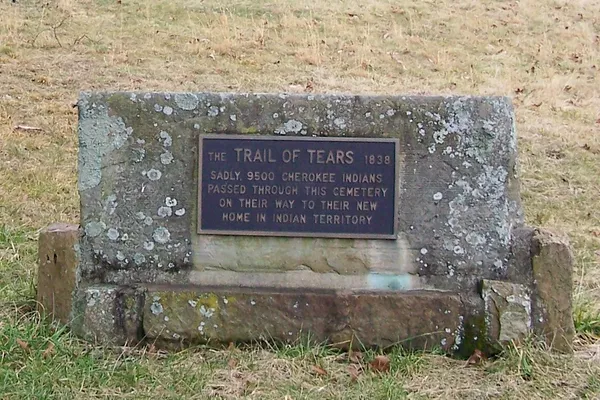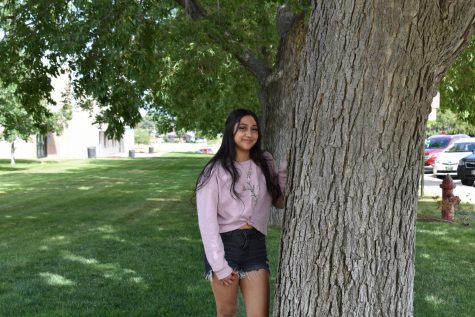The Trail of Tears

Trail of Tears Monument
May 16, 2022
The Trail of Tears happened between 1830 and 1850 by the United States government. It is usually taught that the Trail of Tears is only related to the removal of the Cherokee Tribe, but the Choctaw, Seminoles, Chickasaw, and Creeks have their own Trail of Tears. Each of these groups has a unique experience of misery, violence, and pain. Nonetheless, this story focuses primarily on Cherokee removal.
George Washington, the first president of the USA had promised the people that he would take care of what was called at the time the “Indian Problem.” His idea of dealing with this “problem” was fixed on protecting white settlements and not the Natives. During the 1800s, Native Americans were living all over the United States. This story is about indigenous tribes that lived in and around the Southeastern part of the country.
This upset the white settlers because they saw the Natives as alien people hogging this land that the white colonists felt they deserved. George Washington came up with the idea of trying to make Natives as much like White people as possible. The way to do that was to convert the Natives to Christianity and teach them how to read and speak English. Basically, the white people moved on to rakes and hoes while the Natives were still planting seeds with their hands; so, the colonists saw the Natives as old-fashioned. The Colonists wanted the Natives to do things their way or get out of their land.
The settlers wanted the Natives’ land so that they could grow cotton and apply their European farming practices. Many Native tribes lived on fertile lands. By the 1830s, cotton was the United State’s number one export. Colonizers wanted to create a new American civilization and erase the America that already existed, they wanted a blank slate. Since the colonizers defeated the British, the colonizers felt like they were owed this land and deserved to create their own land.
The Natives were not giving up their land. This frustrated the white people who the Natives called squatters, (A squatter is a person who unlawfully occupies an uninhabited building or unused land). At this time, a big priority of the colonizers was expanding the nation and moving forward. In their eyes, the Natives were stuck in the Stone Age. The Natives shared the land, but the settlers were obsessed with private property. The Natives were sitting on fertile ground and were ready to print money in the form of cotton, but the colonizers wanted it. As a nation, they were trying to build an identity at all costs. This meant having a lot of land and resources.
The Natives still did not want to leave their land because they didn’t need to and the colonizers were wanting to make a plan to make the Natives leave. At this time, Andrew Jackson was a major part of making the Tail of Tears happen because he did not like the Native Americans, he was not afraid to get rid of anything standing in his way, and he figured out that if he kicked Native Americans off of their land, he could take it. Andrew did this and got Flordia and parts of Alabama and Georgia. He got a baby and the title of War Hero out of it.
Andrew hated the Native Americans because he had a vendetta against them. His brother was killed by the British in the Revolutionary War and the Natives were working with the British in the north. In his eyes, a friend of his enemy is his enemy. When Andrew ran for president, many people looked to him to take America to the next level. When a person is running for president, they come with a long list of talking points to present to the American people in hopes of getting their votes. For example, Nixon was going to bring law and order, Reagan was going to win the war on drugs, Trump was going to build his wall, and Andrew Jackson was going to get rid of the Native Americans.
Rarely do these presidents achieve what they said they were going to accomplish. With Andrew, he was talking a big game, but very little happened. During his first term as president, he signed the Indian Removal Act. It was a law signed by Andrew Jackson to remove the Native Americans from their land and there was nothing the Natives could do about it. This became priority number one for Andrew Jackson. He claimed that this was for the Native Americans’ own good. His plan was to take their land through contracts and treaties and then tell them that they should have more land, not this land. He was wanting them to move more west to Oklahoma.
Andrew kept taking more of their land and giving them other land further away. The language and this law say that it is supposed to be voluntary. So, both parties would have to agree to it. Since it is voluntary, the Native Americans did not want to move and they stayed put. They did not volunteer to walk 1,000 miles to where Jackson was wanting them to head to. Since the Natives weren’t leaving, he was now setting his sights on the Choctaw Tribe.
At this time, white people did not hate the Choctaws as much as they disliked other Native Americans because Choctaws fought alongside them in the war of 1812. The Choctaws signed a deal with the government that offered a huge plot of land in Oklahoma in trade for their land in Mississippi. In 1831, the Choctaw became the first Native Tribe to be kicked out of their land altogether. They made the journey to Oklahoma on foot with no food, no supplies, and no other help from the government. Thousands of people died along the way. One Choctaw leader told a newspaper article that it was a trail of tears and death. This is where the name of this story comes from.
Today the Choctaws call this event “removals” because of how closely the name Trail of Tears is tied to the Cherokee removal. The Choctaw Tribe was the first group to relocate even though they had a good relationship with the white people for fighting alongside them in the war of 1812. Since the Natives saw how the white people and government treated the Choctaws, they did not want to relocate. Now, Andrew is wanting the Seminoles to move after he tried to make them leave Florida so he could take the land over. Now that he wants them to move again, they were prepared and ready to take the United States to war.
In this war, they used all sorts of guerrilla tactics and had formerly slaved people fighting alongside them. The war ended up costing Andrew Jackson about 40 million dollars. The Seminoles fought for 13 years, 3 wars, and kept getting crossed by the government. Eventually, the United States government let them keep some of their land in Flordia around the Everglades, but there were others that took payment and headed off to Oklahoma. The next tribe, the Creeks, did not want to leave their land. They had already lost their land because of Andrew Jackson in 1814 before he was president.
The Creeks came up with an agreement with the United States government and signed some documents. The agreement was the government would protect their land as long as they gave the government some of it first. The government did not end up cooperating with the deal when the Creeks were cheated out of their land by colonizers. Since the government did nothing to protect them, the Creeks were furious. They stole livestock and burned down the farms of settlers Because of this, the government forcefully removed the remaining Creeks. Since this was happening, the government stepped in, but not to help or protect the Creeks; it was to forcibly remove the remaining Creeks.
In 1837, 15,000 Creek nation people would migrate to what the United States government called the Indian Territory and what is now called Oklahoma.
The Chickasaw tribe saw everything a bit differently than the other tribes. Instead of staying and declaring that they need to defend their homeland, they chose to come to an agreement in 1832 because they knew what could happen if they didn’t. They took the payment, left their Native land in 1837, and relocated to Oklahoma. Not only did these people have to walk to Oklahoma, but they also had to give up their homes too. This isn’t just about losing homes, land, or money. The Chickasaw tribe viewed the land differently than the colonizers. They have been fine without western money for generations. This was about the potential for them to lose their souls, their spirituality, their identity, and their future. This is something all of the tribes had to deal with.
Many years before, the Cherokee came to an agreement with the United States that their land in Georgia belonged to the tribe. This had upset Andrew Jackson because he wanted their land. He claimed that it was unconstitutional for Natives to have their own land without the state approving of it. The state did not agree with Georgia and they were not approving of this. The options for the Cherokees were that they either were going to give up their land or there was going to be problems. The Cherokee tribe however stayed put on their lands because they had come to an agreement.
Around the time the Indian Removal Act was signed into law, somebody found gold by accident on Cherokee land. Georgia ended up passing a law that said all gold, silver, and other mines found within Georgia’s land were the property of Georgia, even if it was on Cherokee land. It only took two and a half weeks for the Georgia government to step in and seize the Cherokees’ land. Since there was gold found in the area, there was much more urgency to step in. The Cherokee would not give up easily and took their case all the way up to the Supreme Court.
The court ruled that the states could not make laws that went against treaties with the Natives and that the federal government needs to make sure white intruders stayed out of Native land. The Supreme Court agreed and told Georgia that they could not take Cherokee land. When the Supreme Court wouldn’t let the United States have the Cherokees’ land, Andrew pretended that he knew nothing about it. He went against the treaties and figured that in a nation as big as the Cherokees, there had to be a few of them who were willing to negotiate. He reached out to about 500 tribe members and offered them a “good” deal and money was offered to help relocate the tribe to Oklahoma. They would compensate for any lost property on their journey or anything that got left behind and in trade, the United States would get all of their land. 500 of the Cherokee people signed the deal.
The issue was that although they were members of the Cherokee Nation, they weren’t leaders of the tribes; so, they weren’t allowed to speak for the Cherokee Nation as a whole. The leader of the tribe was a man named John Ross. “in 1823, Georgia officials, recognizing Ross’ growing power, dispatched a Creek chief to personally offer him $2,000 (about $42,300 today) to persuade the Cherokees to move.” Ross had asked for the offer to be in handwriting. He then took it to the Ridge and exposed the bribery attempt in front of the tribal council and sent the emissary packing. He was the principal chief and he did not sign the agreement. It upset him so much when he found out others had signed it. He then started his own petition in protest of the deal. The principal chief was able to get 16,000 members of the Cherokee tribe to sign his petition. When Andrew saw the signatures, he ignored them. Once the treaty was signed and sealed with those original 500 members who agreed to it, it was a done deal and the land belonged to the United States (The Cherokees Vs. Andrew Jackson).
The government gave the Cherokee two years to get out and promised them that if they didn’t leave the land, they were going to be removed by force. The Cherokee Tribe waited for a couple of years for Andrew Jackson to not be president anymore. They thought that maybe this new president that comes in will have their back and let them keep their land. The next president that came into office was smart, skilled, and a very educated politician. This was Mr. Martin Van Buren. The tribe thought that he would be the one to save them and their land, but Buren had no problem finishing what Andrew Jackson started.
At this time, the United States was dealing with a major financial crisis. Quickly after taking over office, Buren sent troops to the Cherokee Nation to round up every member of the tribe and imprison them in what we now consider concentration camps. At the time they considered them holding camps to get them ready for their upcoming journey, but in reality, these places were horrific.
By the year 1838, 2,000 Cherokees had voluntarily left and headed to Oklahoma and 16,000 Cherokees remained on their land. Again, the US government stepped in, this time sending 7,000 troops to force them out. When the troops came in, they went into the Cherokees’ homes and threatened their lives if they didn’t leave. Parents or children that returned home from work or from playing, came home to find that their family had been kicked out. In some cases, dinner was still on the table. They were not allowed to grab any of their belongings and as they left, their homes were looted.
The remaining Cherokee on their land, were sent to the holding camps and were kept in close quarters, under such intense guard, that any ounce of privacy was impossible and there were no toilet facilities. At times, they would have to lie naked on the ground, often exposed to the hot sun and awful weather. Due to the brutal and inhumane conditions, many would end up passing away. About 2,000 Cherokee died from disease there. With nothing left, many of the Cherokee members began the march known as the Trail of Tears. They were heading to the Western lands on foot and over the next year, the Cherokee tribe would split up into small groups. Since there wasn’t just one path, the groups each took their own path to get to Oklahoma. The average mileage one would walk in the summer was around one thousand miles on foot. They walked from Tennesse to Oklahoma.
On the walk with them, were government troops that would follow, lead, and watch the Cherokee Tribe for about one-third of their journey to make sure that they were doing what they were supposed to be doing. They would travel about 10 miles per day in a three-mile-long caravan of people. Some of the young and elderly people would ride in wagons, while everyone else was on foot. It didn’t matter if it was boiling hot, muddy, or snowy; they didn’t have a choice but to walk and a lot of them didn’t have their belongings with them.
For food, they would mainly eat salted pork and flour, but there wasn’t enough of it, so they had to find food as they went. Sometimes people would venture off from the group to go hunt for turkeys or deer which they would use to feed themselves. It wasn’t always available, so people starved, especially during the winter. It was a long journey and water was also a big challenge. The other water source was the rivers. The Mississippi River had to be crossed and it was not a smooth or calm river. There were no paved roads or bridges, and it was super deep and unforgiving. All of their stuff, if they had any would be soaking wet and half of the river would be frozen during winter.
Being wet from the water would lead to all sorts of diseases and any disease that showed up on the trail would run rampant among everyone. These were diseases that are mostly preventable now such as dysentery, measles, and whooping cough. At this time, in conditions like this, even a fever could kill. These diseases killed so many people that they had to bury their loved ones along the way. The soldiers that were supposed to protect and guide them, were sexually abusing the Cherokee women and by 1939, the relocations finally came to an end.
The exact number of Cherokees that died on that journey is still not known today, but the most common estimated number is around 4,000, which was about 25% of the entire Cherokee Nation at the time. The Cherokee Tribe was assigned different areas in what is now known as Oklahoma; which was once an unsettled, empty open land. “A new Supreme Court building quickly followed in 1844, along with the resurgence of the tribe’s newspaper, schools, businesses, and other entities.” The Cherokee people were happy until the Civil War pulled the tribe apart again. Then, the United States decided to turn Oklahoma into an official state. This meant that the Native Tribes no longer were in complete control over their land (Cherokee Nation).
When they arrived, they managed to rebuild the Cherokee. The United States had made promises to the Native people that they went out of their way to break. Not all of the Native people in the southeast made the journey on the Trail of Tears. There are still small groups of each tribe in their original homeland, but the bulk of their land ownership was moved to Oklahoma. These Oklahoma territories are still there to this day. They are occupied by the Creeks, Seminoles, Choctaw, Chickasaw, and Cherokee people; unfortunately, even today, the government looks for ways they can take more of their land.
The Black Hills area where Mount Rushmore is was sacred to the Lakota and Cheyenne Tribes, then, settlers discovered gold in that region. Recently, Native groups were furious because the Keystone Pipeline in South Dakota was cutting right through their land and it posed a huge risk to the wildlife that they needed to hunt for food, the drinking water, and their safety. Big Oil went for it anyway and just like the Natives predicted, the pipe bursts and made a huge oil spill, only to have the project canceled a few years later.
All five of the removed tribes stand as successful sovereign nations proudly preserving cultural tradition while adapting to the challenges of the 21st century. In particular, the Cherokee removal is considered to be one of America’s darkest moments in history. In 1987, the United States Congress turned the Trail of Tears into a national historic trail. “The Trail of Tears is over 5,043 miles long and covers nine states: Alabama, Arkansas, Georgia, Illinois, Kentucky, Missouri, North Carolina, Oklahoma, and Tennessee.” The Trail of Tears National Historic Trail is run by the National Park Service. Parts of it can be traveled on foot, by horse, or by bicycle or car. It is shorter than what the Native Americans had to walk. It wasn’t until 2004 that the United States Senate offered a formal apology for what had taken place during the Trail of Tears. The original colonizers wanted to eradicate the Native Americans. They chose Oklahoma because it was a hard place to live in due to there being absolutely nothing. Andrew Jackson wanted a white nation and the colonizers wanted more land to exploit. The Native Americans just wanted to be left alone and live on the land that they called home for centuries before Europeans ever showed up (Trail of Tears).
H.E. (2009, November 9). Trail of Tears. HISTORY. Retrieved May 14, 2022, from https://www.history.com/topics/native-american-history/trail-of-tears
Cherokee Nation. (n.d.). Cherokee Nation. Retrieved May 14, 2022, from https://www.cherokee.org/about-the-nation/history/
The Trail of Tears and the Forced Relocation of the Cherokee Nation (Teaching with Historic Places). (n.d.-b). National Park Service. Retrieved May 14, 2022, from https://www.nps.gov/articles/the-trail-of-tears-and-the-forced-relocation-of-the-cherokee-nation-teaching-with-historic-places.htm
The Cherokees vs. Andrew Jackson. (n.d.). Smithsonian Magazine. Retrieved May 14, 2022, from https://www.smithsonianmag.com/history/the-cherokees-vs-andrew-jackson-277394/











